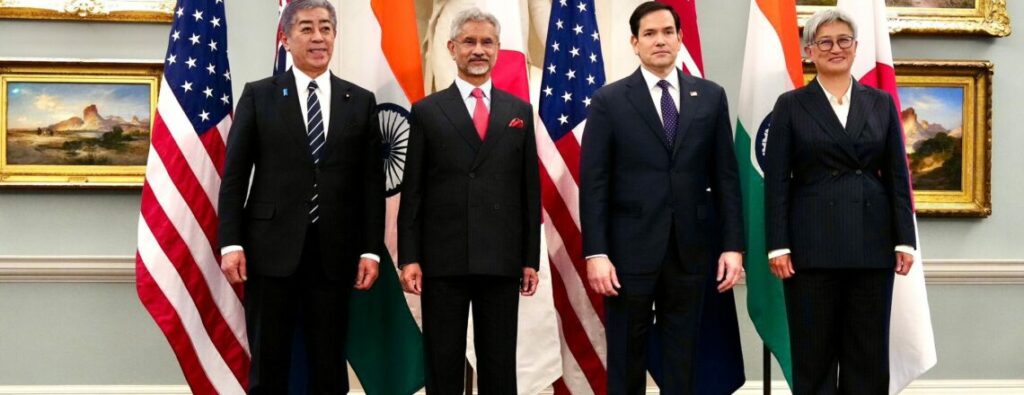
- The Quad’s foreign ministers’ meeting emphasised how managing the intra-group frictions had become as much the point of the Quad as taking on Beijing’s advances.
- Such undercurrents of mistrust consign the Quad to be no more than a diplomatic photo-op, as opposed to being a coherent security architecture.
- Experts like Arthur Sinodinos point to the abundance of working groups now numbering over a dozen, with few specifying timelines or funding allocations.
- If the Quad is to emerge from its Washington rendezvous with credibility intact, its members must turn shared words into shared deeds.
The foreign ministers of the Quadrilateral Security Dialogue (Quad), Australia, India, Japan and the United States, met in Washington, DC, on July 1, 2025, amid increased great-power competition in the Indo-Pacific region and tensions of their own making within the loose grouping. Helmed by U.S. Secretary of State Marco Rubio, the meet-up was advertised as a chance to “reaffirm our shared commitment to a free and open Indo-Pacific,” while commitments were made to strengthen maritime security, deepen economic cooperation, and increase supply-chain resilience. But as the Quad’s foreign ministers sat in the ornate halls of the State Department this week, what this ministerial emphasised was how much managing intra-group frictions had become as much the point of the Quad as taking on Beijing’s advances.
At its heart, the Quad was born of a mutual strategic imperative: to check China’s increasingly coercive economic and military posture across the region. From Beijing’s militarisation of disputed features in the South China Sea to its extensive Belt and Road infrastructure footprint, the four democracies share anxieties over threats to sovereignty, freedom of navigation and the integrity of critical supply chains. State Department spokesperson Tammy Bruce made no secret of these concerns, underscoring that the meeting would centre on “upholding sovereignty, enhancing maritime security and creating resilient supply chains”. For India, represented by External Affairs Minister S. Jaishankar, such language resonates deeply with New Delhi’s own “Act East” ambitions and its effort to maintain strategic autonomy while engaging Beijing in both competition and dialogue.
Yet the Quad’s promise of unity on China has been repeatedly tested by bilateral tensions among its members. President Trump’s global tariff offensive has ensnared all four partners: Australia chafes at proposed duties on its critical-mineral exports, Japan has pushed back against U.S. demands for higher defence spending, and India bristles at American assertions that tariffs averted escalation with Pakistan after the April killings of tourists in Kashmir. Washington’s high-profile review of the AUKUS submarine pact has only increased Australia’s discomfort, with Tokyo postponing a planned annual defence dialogue in response to Pentagon pressure. Such undercurrents of mistrust consign the Quad to be no more than a diplomatic photo-op, as opposed to being a coherent security architecture.
Against this unsettled canvas, the July 1 ministerial sought to advance concrete deliverables. The joint statement touched on an array of workstreams from counter-terrorism and pandemic preparedness to digital technology, artificial intelligence and critical-mineral security while announcing new dialogues on vaccine manufacturing and cyber norms. Australia’s foreign minister, Penny Wong, stressed the importance of launching formal discussions between Prime Minister Anthony Albanese and President Trump, claiming closer personal ties would help ease tariff risks in return for ‘first in line’ access to Australian minerals. India, for its part, managed to extract a pledge to enhance ongoing maritime domain-awareness exercises and to turn some infrastructure projects into priority projects under the Quad’s Indo-Pacific Partnership for Critical and Emerging Technology.
Nevertheless, the minister underscored a familiar criticism of the Quad: the gap between rhetorical consensus and actionable follow-through. Experts like Arthur Sinodinos point to the abundance of working groups now numbering over a dozen, with few specifying timelines or funding allocations. Civil-society observers fear that there is a danger of high-level declarations about climate resilience and development assistance being drowned out by the headline-grabbing circus being played out in trade spats and defence-spending lectures. And regional partners, like the ASEAN nations and Pacific Island states, have come to resent being bypassed by a group they view as insular and U.S.-led, not truly consultative.
For New Delhi, the act of balancing is particularly gruelling. India is committed to the Quad’s agenda of an inclusive Indo-Pacific, but New Delhi is also wary of being typecast as nothing more than an anti-China bulwark. The call, by Jaishankar, to “keep the trend going in the positive direction,” while acknowledging that “relationships will never be free of issues,” mirrors the broader Indian hedging of much closer ties with Washington and Tokyo, while not shutting off dialogue with Beijing. This posture’s sophistication has won plaudits, but it also provokes the question of just how enduring the Quad might prove if India ever decides that its core interests conflict with U.S. or Japanese objectives.
In the coming months, the Quad will be put to a test of historic proportions when its leaders meet in India later this year. In order for the grouping to maintain its strategic salience, it has to confront and get over three imperatives. First, it should narrow its workstreams into a smaller number of priority initiatives with measurable goals, especially in the areas of critical-mineral supply chains, climate adaptation finance and advanced-technology governance. Second, it needs to more actively embrace regional institutions, from the Indian Ocean Rim Association to the Pacific Islands Forum, to assuage fears of exclusion and to tap into local leadership. Finally, the Quad will need to figure out how to depoliticise its cohesion: to buffer security cooperation against the ups and downs of U.S. domestic politics and bilateral trade rows.
As the foreign ministers dispersed from Washington this week, they carried with them the weight of both promise and frustration. The Quad’s evolution from a 2007 “Asian arc of democracy” to a nascent security partnership has been steady but unspectacular. The outcome of the July 1 meeting will be judged less by joint statements than by the tangible progress of projects on the water, in the boardroom and in the data centres of the Indo-Pacific. If the Quad is to emerge from its Washington rendezvous with credibility intact, its members must turn shared words into shared deeds. The region and the world will be watching.
References:
- Australian Government, Department of Foreign Affairs and Trade. (2025, July 1). Remarks by Senator the Hon Penny Wong, Minister for Foreign Affairs, at the Quad Foreign Ministers’ Meeting, Washington, D.C.
- Bruce, T. (2025, July 1). Press briefing on the Quad Ministerial. U.S. Department of State.
- Jaishankar, S. (2025, July 1). Statement by External Affairs Minister Dr S. Jaishankar at the Quad Foreign Ministers’ Meeting, Washington, D.C., Ministry of External Affairs, Government of India.
- Lowy Institute. (2025). Interview with Arthur Sinodinos on Quad deliverables and strategic coherence.
- Ministry of Foreign Affairs of Japan. (2025, June 30). Statement regarding the postponement of the annual Japan–U.S. Defence Dialogue.
- Reuters. (2025, June 15). U.S.–Australia tariff tensions over critical minerals trade.
- The Diplomat. (2025, May 20). Analysis: How Quad’s working groups struggle to move beyond rhetoric.
- ASEAN Secretariat. (2025, July 1). Communiqué on the importance of inclusivity in Indo-Pacific partnerships.
- Pacific Islands Forum. (2025, June 28). Statement on engagement with major external groupings.
- U.S. Department of State. (2025, July 1). Joint statement of the Quad Foreign Ministers’ Meeting on maritime security, supply-chain resilience, and technology cooperation.
Shashank is a Master’s student in Diplomacy, Law, and Business at O.P. Jindal Global University. He is also a researcher and coordinator at the Center for Global South and the Center for Southeast Asian Studies. His research interests include Southeast Asia, Chinese foreign policy, India’s Act East Policy, and global security dynamics. Views expressed are the author’s own.
